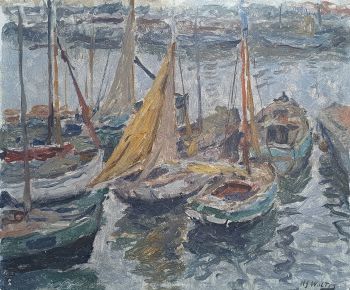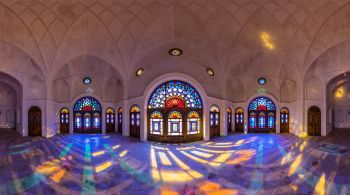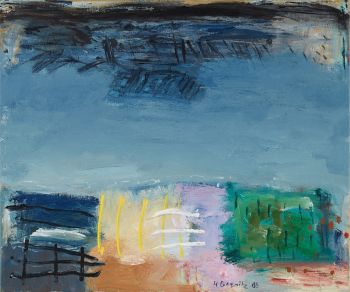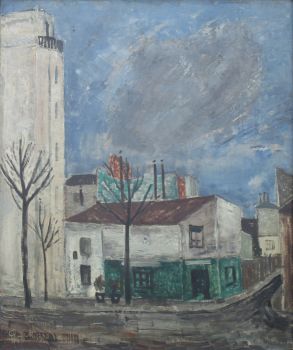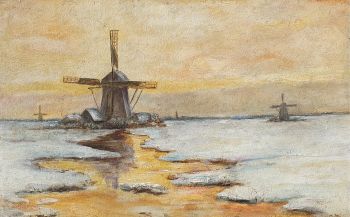Sandy bank with farmyard and trees – Zandheuvel met boerderij en bomen 1880 - 1950
A.J. Lachaud
LegnaTavolaPittura a olioDipingere
13.70 ⨯ 18.80 cm
ConditionExcellent
€ 600
Klooster Fine Art
- A proposito di opere d'arte[EN]
This charming small oil sketch was probably painted outdoors, and seems to have been intended as a study of colour, light and shadow. With a thick impasto and fluid brushwork, the artist seems to have worked at speed producing this picture. Throughout the sketch, the unpainted canvas covering the artist's board can be seen in small patches. Parts of the thicker impasto seems to have been flattened, possibly by the lid of the painter's box, or the paint resting against another board. The painting was signed in the bottom right, 'A.J. Lachaud', which may be Adolphe Jean Lachaud (1889-1952), who later went by Jean.
As a carrier, the painter used an artist's board, produced by G. Sennelier, of which a label is still on the reverse of the picture.
[NL]
Dit aantrekkelijke Kleine olieverfschilderijtje werd waarschijnlijk in de buitenlicht geschilderd, en lijkt te hebben gediend als een manier op kleur, licht en schaduw te bestuderen. Door het vloeiende penseelwerk met dik impasto lijkt het werk snel geschilderd te zijn. Door de wijze waarop het werk geschilderd is, is de drager zichtbaar op kleine plekjes door het hele werk heen. De opstaande verf heeft een platte bovenkant, mogelijk doordat het paneeltje tegen een ander werk aan heeft gestaan toen de verf nog niet helemaal droog was. Het schilderij is rechtsonder gesigneerd ‘A.J. Lachaud’, wat Adolphe Jean Lachaud (1889-1952) kan zijn.
Als drager gebruikte de kunstenaar een kunstenaarsboard – een soort karton dat met textiel is bespannen. Op de achterzijde zit een label van de producent G. Sennelier. - A proposito di opere artista
Nato a Parigi (18° arrondissement) il 27 dicembre 1889, morto nell'agosto 1952 a Brest, Adolphe Jean Lachaud è stato un pittore, incisore, ceramista e decoratore stabilito in Bretagna.
Laureato in lettere, frequenta il liceo Condorcet a Parigi. Scoprì la Bretagna nel 1908, durante i soggiorni familiari a Pont-Aven. Fu poi studente all'École nationale supérieure des Beaux-arts e poi all'Académie Julian.
Mobilitato nell'Aeronautica Militare nel 1914, andò al fronte con la 44a Field Aerostation Company. Fu poi distaccato come istruttore presso l'esercito americano. Ha ricevuto la Croce del Combattente, la Medaglia commemorativa di Verdun e la Croix de Guerre.
Smobilitato nel 1919, si stabilì definitivamente in Bretagna, prima a Nevez vicino a PontAven fino al 1934. Qui viveva suo fratello Jacques Lachaud, architetto, che vi acquistò e restaurò un mulino.
Le sue prime xilografie furono esposte nel 1921 al Salon d'Automne di Parigi, di cui era membro, così come al Salon de l'art française independant. Nel 1923, produce le sue prime ceramiche presso le fabbriche di maioliche Henriot di Quimper, sotto la marca di pesce tagliato Saint Corentin.
Sposò Eugénie Mahévas nel 1929 poi Anna Consolat nel 1941. Nel 1933 abbandonò il nome Adolphe e mantenne solo il secondo nome Jean; le sue opere sono ora firmate Jean Lachaud.
Si trasferisce a Quimper nel 1934 insieme al fratello architetto Jacques Lachaud (1893-1973), uno dei fondatori
del regionalismo architettonico bretone. Ha creato l'Unione Artistica di Quimper.Nominato curatore del museo di Brest nel 1936, organizza il salvataggio delle collezioni all'inizio della guerra 1939-45. Nominato anche direttore della Scuola di Belle Arti di Brest, è come insegnante e curatore che conclude la sua vita e carriera nel 1952.
Sei interessato ad acquistare questa opera d'arte?
Artwork details
Related artworks
- 1 - 4 / 24
Marcel Jefferys
Jeune femme au collier dans un intérieur1890 - 1922
Prezzo su richiestaStudio 2000 Art Gallery
Bernardus Johannes Blommers
VADER EN MOEDER MET KIND AAN TAFEL1845 - 1914
Prezzo su richiestaStudio 2000 Art Gallery
1 - 4 / 24- 1 - 4 / 24
Johannes Evert Akkeringa
'Nettenboetsters' in the Dunes1861 - 1942
Prezzo su richiestaStudio 2000 Art Gallery
Willem van Konijnenburg
Landscape in Limburg, the south of the Netherlands1868 - 1943
Prezzo su richiestaKunsthandel Pygmalion
1 - 4 / 24- 1 - 4 / 12




